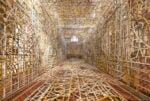Carol Rama / Jamie Sneider – Endless Revisions
 (443x480).jpg)
Mostra doppia personale
Comunicato stampa
NEOCHROME is pleased to present Endless Revisions, a duo project hosting works by Carol Rama and Jamie Sneider in their aesthetic conversation.
In approaching a group exhibition, we as viewers enter with certain expectations. We expect to find common ground in comparison; we assume also that contrast will provide a clearer sense of each artist involved. More importantly, we anticipate structure, a theme, a reason—some thread of continuity that shows how the art on view asks similar questions but arrives at distinct but equally meaningful insights.
This is particularly true in two-person exhibitions, where the prospects of comparison and contrast become more direct, more pointed—and, potentially, more profound. In the case of “Endless Revisions,” we find a selection of works by Italian artist Carol Rama (1918-2015) and New York-based artist Jamie Sneider (b. 1976). In appearance, the installation is generously structured, varied in format, subject and scale. Given investment, however, one also finds resounding throughout these works an effect not dissimilar to smoldering: quiet, even unassuming exteriors that belie underlying inflammations.
From the outset, Carol Rama’s work merged notions of family, fantasy and flesh. The artist first gained notoriety for (and, indeed, censorship because of) her 1940s-era watercolor compositions: freehand compositions of stylized, sexualized female forms, all protruding organs and fluids spilled, the images were wild, willfully crude and yet oddly sweet, echoing Schiele’s nervous energy and anticipating Lassnig, Bourgeois and Clemente alike. Over the succeeding seven decades, Rama would experiment with a broad range of materials and techniques, from gestural abstraction to bricolage of found debris. But as much as her medium varied, her work retained a singular effect: overtly sexualized but somehow celebratory, violent but always vital.
Rama’s contributions to “Endless Reviews” come from two particular periods: the mid-‘60s, which found her focused on minimally composed paintings rendered in splashed patterns of ink, enamel and acrylic glue, respectively; and the early 1970s, by which time the artist had turned her attention to mixed-media collages built on dissected pieces of bicycle rubber. Adopting tropes standardized in Abstract Expressionism, the former grouping is apparently formal but nonetheless provocative, the patterns evoking splattered bodily fluids; the latter, meanwhile, finds its sensual effect in the interacting textures of overlapped rubber, the results a willfully tactile departure from post-Art Informel assemblage. As is typical of Rama’s output, each approach makes direct reference to modernist styles but never fails to inject a dose of corporeality, adding blood to what could otherwise have been a mere intellectual exercise.
While Jamie Sneider’s work to date has been similarly varied in its execution, ranging from performance and video to multi-media sculpture, the artist is perhaps best known for her ongoing series of stained-canvas paintings. Using a variety of grounds ranging from raw canvas to fine fabrics, Sneider produces her paintings by soaking them in a series of colored liquids adopted from traditional domestic dyeing practices: raw pigment, squid ink, lemons, urine, bleach. Manually working the fabrics over repeated treatments, she allows the liquids to absorb in random but intricate patterns; once stretched, the canvas becomes a kind of undulating landscape, the result at once a discrete image and documentation of a process enacted.
Like Rama, Sneider’s work has long addressed issues of sexuality and biography, particularly as they relate to women. In recent years, the artist has increasingly translated those interests via sculpture, much of it referencing industrially fabricated instruments typically found in institutional settings (metal partitions, bedpans, mobile curtain frames), which she either uses as is, or casts and reproduces in concrete or clay. Sneider continues these lines of work in “Endless Revisions,” presenting a series of layered abstract canvases alongside a marble-dyed concrete mold of an institutional food tray, finger-molded and hung on the wall like a small painting. As is true of much of her output, the works favor a reduced formal language reminiscent of both Minimalism and Conceptual Art—but where those styles eschewed representation, Sneider appropriates their aesthetics as vehicles for a kind of abstract figuration, instruments in addressing “messier,” more emotional motifs.
As contrast goes, there are a few notable differences between the two artists—in era, of course, but also in working method: Rama, something of a shut-in, would work only in her home studio, whereas Sneider, a constant traveler, regularly produces work in foreign settings, often incorporating elements and references to those environments in the resulting works. Where Sneider’s work is closely tied to research, Rama’s work, though hardly haphazard, was comparatively impulsive. One could go on—but as is made evident in “Endless Revisions,” whatever the two artists’ differences, far more prominent (and more compelling) are their commonalities. To begin with, each grounds her work in themes of biography, female sexuality and (self-) representation. Each has a flair for the theatrical and, when so inclined, injects a great deal of humor into her work. At the same time, in their quieter moments, each offsets controlled treatments with charged reference, the results falling somewhere between formalism, visceral expression and bare sentiment.
Of these various parallels, however, two themes in particular bear discussion. The first involves notions of embodiment. Rama’s work has long been dense with corporeal iconography: lapping tongues, teeth (both pointed and false), splattered fluids, defecation, bestiality—the artist was never one to shy away from baser sides of the body. In describing her painting process, meanwhile, Sneider routinely emphasizes its physicality—the manual, almost performative effort involved in working the canvas, forming the molds, sculpting her materials. Approaching the figure as something at once carnal and ephemeral, Sneider and Rama each find much of their content in the notion of the body-as-object: possessing a body, exposing and exploring that body, feeling at times detached from that body, and even fearing (resenting?) that body for it’s autonomy: its natural workings, its vulnerability and, most of all, its inevitable decline, which arrives and unfolds almost as a betrayal. Though outwardly a symbol of vitality, there’s a definite thread in both artists’ work that speaks to bodily function as it relates to survival—particularly in the face of failing, as those functions are delegated to caretakers or, more pointed yet, to an institution.
All of which leads us to the second primary motif: that of loss. Though hardly definitive of either artist’s catalogue, loss—specifically, paternal loss—has served each artist as an ongoing source of both motivation and content. Each has described their work in such terms: Rama, for one, routinely cited her mother’s mental illness and father’s eventual suicide as direct catalysts for her work, while much of Sneider’s recent offerings have emerged as response to the process of losing her mother. What’s fascinating, however, is how each translates those experiences in distinct but similarly distilled fashions. Rama’s work reads largely as response, her use of rubber in particular taking on a fetishistic quality—not only in terms of sensual gratification, but more importantly, in the true sense of the word: as “an inanimate object worshiped as if inhabited by a spirit.” In Sneider’s work, meanwhile, one finds questions not only of aftermath, but also of loss as a process, a departure unfolding in stages. If so inclined, for instance, one could easily read Sneider’s layered paintings as evoking beds—specifically, sickbeds, soiled and wrinkled with use, suggesting a recent presence—which is to say nothing of the bedpans, partitions and food trays. There is a clear preoccupation on both artist’s parts with exploring how one might evoke a bodily presence through non-literal strategies of figuration. Centering that process for each is the idea of the memorial—the constructed object serving as placeholder for passed connection, corporeal weight. Theirs becomes, in other words, a treatment of object-as-body: a dearth rendered physical; an absence acknowledged, even anticipated, despite ones effort to prolong presence; loss at once registered and actively resisted.
So what, then, of “Endless Revisions”? In part, the title speaks literally to process—think of Sneider’s repeated submergence of fabrics in dye, the constant folding, or the recycling of aprons, used in prior performance, as part of the paintings on view. It also reflects the variance that defines both artists’ catalogues, the way longstanding themes are translated across distinct phases. But even more striking is how the title reinforces their shared penchant for translating ongoing themes through unconventional—but specifically chosen, emotionally resonant—materials. Rama’s use of rubber in the ‘70s, for instance, directly evoked memory of her father, who oversaw a bicycle tire factory in Turin. Rather than present the material literally, however, Rama undertakes a series of interventions—dissection, puncture, stretching, layering—and in doing so, yields a surprising range of tone and texture. Sneider’s use of materials is equally metaphoric—in her evocation of institutional wares, certainly, but even in her very production of abstract painting, a pursuit shared with her artist mother, a former Abstract Expressionist. Like Rama, Sneider finds meaning in the design of her materials but still insists on transforming them, leaving her literal imprint via casting, pouring, and manual handwork. In each case, we find the artist drawing symbolic resonance from fabricated elements, the resulting works offsetting design and function with aesthetic revision.
This in mind, one finds her thoughts drawn to architectural ruins. On a basic level, ruins embody notions of impermanence, progression, the passage of time. Afforded aesthetic consideration, they render these notions monumental, decorative. They are traces, their enduring presence at once physical and symbolic. Particularly in the case of landmarks, the ruin represents the desire to live with the past, however dissipated. It reflects a decision made—to preserve rather than demolish; to remember rather than forget. It’s something that future development is built around rather than over. It strikes me that all of these impulses find direct translation in both Rama and Sneider’s output. Each deals with images (literal and figurative) of amputation, fragmentation, the piece left in place of the whole; in both practices, we witness the ability of objects—signs of what was—to assume new narratives, ambiguous meaning, fresh and unforeseen narratives. Endless revisions.
Grief, it’s been said, demands an answer—and wherever one is not readily available, it will inevitably be created. This much seems borne out in both artists’ contributions, each having allowed personal narrative to shape her art to singular but similarly provocative ends. This is vulnerable, even confessional work—and in that alone, there’s compelling content, a vital edge. But to reduce these works to mere symptoms of trauma would be to miss what makes their pairing so rich. Each artist has been outspoken in approaching her work as a potential means of healing. It’s an intrinsically hopeful, outwardly reaffirming notion, of course, but more importantly, it also implies a process undertaken. To heal properly, there can be no avoidance of what pains us; one must work with in order to work through. But as seen in the architectural ruin, decay is always a twofold proposition: even in denoting a loss, it promises a flourishing to follow. This is precisely the dual interest of an artist’s aestheticizing of her grief: on one level, it’s an act of confronting, of assuaging, of coming to terms. It’s personal, and thus direct. At the same time, to render decorative is to translate, to reinvent. It provides a slight distance which allows all involved—artist included—to experience (and, indeed, enjoy) the work, in both sentiment and formal strategy, as relating to a broader context. This, I think, is the underlying message being offered in “Endless Revisions.” Confirmed in these works is the idea that a process as personal as grieving finds both articulation and relief when—and, more to the point, because—it is outwardly extended. This, in the end, is the pull of both Rama’s and Sneider’s displays: the notion that through an unflinching engagement of the personal, we might finally arrive at the mutual.
Christopher Schreck
New York City
June 2016



